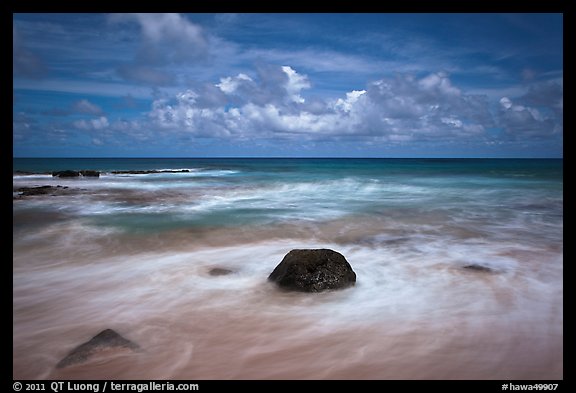Monsoon traffic, Ho Chi Minh City
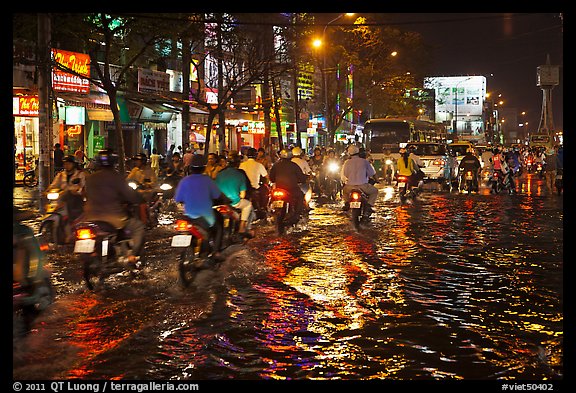
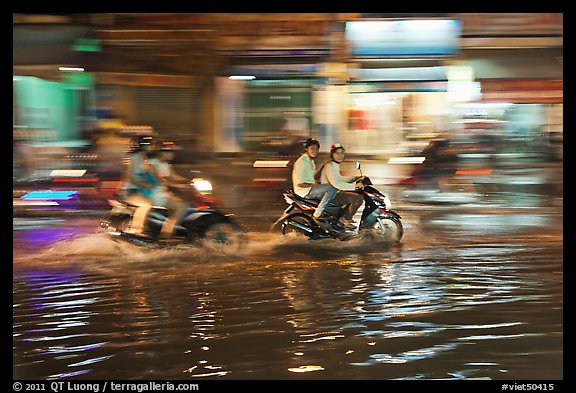
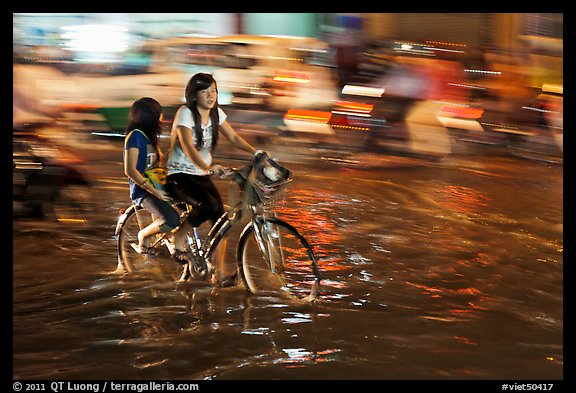

More images of Ho Chi Minh City traffic
Interested in traveling to Vietnam ? Check the Vietnam photo tour that I will be leading in Fall 2012.
|
|
The Terra Galleria Blog – QT LuongQT Luong's updates and thoughts on photography, travel and nature
|




More images of Ho Chi Minh City traffic
Interested in traveling to Vietnam ? Check the Vietnam photo tour that I will be leading in Fall 2012.
The mode of operation of the business was therefore the following: I visited on my own locations of personal interest to me, created photographs there, published them on terragalleria.com, and waited for visitors to find them. This way of doing business worked particularly well for me for two reasons.
On the photography side, this kept the fun and inspiration: functioning as an artist, I was able photograph exactly what I was interested in, in the way I meant to, free of any interferences associated with commercial jobs or external pressures at a time when I was developping my vision. Whether the resulting images would be “saleable” or not was not a consideration, since I feel that all images would contribute something interesting to the website. While peripheral activities such as teaching, writing, and providing other services, can be rewarding on their own, not engaging in them let me devote more time to my photography projects, which were the reason I chose to have a career in photography. This also provided a test of whether my images were strong enough for me to make a living for me and my family from them alone.
On the business side, I have a modest, low-profile personality, which would prevent me from being an effective salesperson. In particular, I am not particularly good at “pushing”, trying to attempt initial contact with specific buyers. This is how most professional photographers operate (top proven ways to promote your photography) because the alternative approach can be expensive. In “pull marketing”, instead of contacting clients, you use mass-media outlets to get clients to respond by contacting you. Traditionally, pull marketing has relied on print, television, and radio. Because of the cost of advertising in those media, pull marketing was used mainly by large companies. That’s where the internet has been a game changer. I was more a mathematician interested in the perception of space than a software developer, but my technical background (CS PhD) still made it possible to create a large photography website using a text editor ten years ago when there were no easy-to-use tools or services for doing so. Although I am not good at coding, I am even worse at cold-calling, having worked in a field where you are judged by your results (science and engineering are areas that use proofs).
The internet has transformed how we access and consume information. Potentially anyone with a computer and a connection from around the world can see your images around the clock, opening up for the first time a line of direct communication between artists and art buyers. People do not visit your website because you handed them a business card, but because they somehow found it on the internet. Yet, this seemingly random mechanism can sometimes provide a number of viewers comparable with traditional media, at an extremely low cost. This makes the internet the first affordable medium for pull marketing. Maintaining and updating terragalleria.com represents a considerable amount of work, however the hosting fees for the dedicated server are less than $250/month.
It’s not just marketing. Unlike in the physical world, it is also inexpensive to own and operate your sales outlet. A gallery would split the sales proceeds, but more importantly, it would carry only a small selection of your artworks. While a gallery does promote its artists, that promotion is split amongst represented artists – not evenly, and not in your favor if you are not a “star”. But the bulk of the promotion effort goes towards the gallery itself. This is even more true of stock photography agencies, with the difference that while good galleries are true partners for their artists, rare nowadays is the agency which has your best interest in mind when making their deals, while many are borderline exploitative. On the other hand, your own website accepts every work you submit: it gives you total control on which work is presented and how it is presented, and no one else is represented there. This was key for letting me publish the images I created by visiting my own locations of personal interest and maximizing revenues from sales. When you sell a product through a third party, most often you need to provide them with an inventory of finished products, such as prints, or fully corrected and keyworded digital files. They can be produced on-demand if you do the fulfillment yourself, saving time and resources.
The bad news with doing business on the internet is that it takes a lot of viewers to make a photography sale. Most people who came to your site just stumbled on it. Therefore, unlike those who go to a shopping site such as amazon.com, they did not come there to buy something. Nor can they be talked into buying something by pushy webpages and a hard sell: those just turn potential clients away. Selling photography on the Internet is a bit like hunting birds by shooting randomly in the sky. In my experience, it requires a considerable amount of traffic, since the ratio of buyer to visitor is only a tiny fraction of a percent. To give some numbers, in the year 2009, terragalleria.com received 5.7 M visits. This was measured using the great Google Analytics, which offers (since 2008) the most accurate site statistics because it automatically disregards numerous visits by the search engine crawlers, unlike for example Webalizer. That year, we sold 267 prints and 148 licenses, which actually generated more revenue than prints. So it took 21,000 visits to sell a print and 38,000 visits to sell a license. True, if we had priced our licenses and prints at a lower point (prints currently start at $350 for the smallest sizes), we would have sold more, but that would have meant more work. We were pleased enough with the balance of revenue and work at our price point, which catered to high-end buyers, but this choice has to be different for each photographer.
In retail marketing, location is everything. On the internet, the equivalent of location is traffic. The good news is that it is possible for an individual photographer website to get high traffic numbers before attracting traditional media attention. Although my images have been widely published – thanks to photo editors finding images on terragalleria.com – my name hadn’t been noticed by a wide audience before the airing of The National Parks: America’s Best Idea which occurred in late Sept 2009. However, by 2004 terragalleria.com had already more than 2 million annual visits (difference between statistics packages factored). The year 2011 is not finished, but the number of visits was 6.4 M YTD, which is 640,000 monthly, or about 21,000 daily. This possibly makes terragalleria.com the most visited of individual photography website this year, although numbers can fluctuate dramatically in way that I cannot predict or understand, as seen in the following graph from Alexa. Unlike Google Analytics, Alexa let you estimate traffic metrics for all websites, not just yours. If the traffic for a target website is above a certain threshold, I have found the statistically-derived metrics to be quite meaningful. Although Alexa provides several statistics, the most significant in comparing different websites is “Reach”. I’ve added for comparison statistics from two other sites. Trey Ratcliff (Stuck In Customs) is the most popular photography blogger and most followed photographer on Google+ at the time of writing, and has a sizeable team working for him. Fotopedia (the publisher of my National Parks App) is the first collaborative photo encyclopedia with more than 750,000 photos, curated by a community of thousands of members, and supported by a VC-backed company with more than a dozen employees.

In the next post in this series about our 10th year in business, I’ll go into some details about how terragalleria.com got that amount of traffic. Part 5 of 6:
Mount Hoffman (10,845 feet, 3,305 meters) is right in the center of Yosemite. For a (relatively) easy to access viewpoint which gives you spectacular bird-eye’s views of the Yosemite backcountry in all directions, it is hard to top this hike. If you do only one high-country summit hike in Yosemite, I would suggest this one.
The hike is accessible whenever Tioga Pass Road is open, although there may be too much snow in the spring. On Tioga Pass Road, about 28 miles from Crane Flat, there is a small spur road marked “May Lake”, which is easy to miss (we did).
Since I planned to hang out on the summit until sunset, Tom (Yosemite Explorer) and I did not get an early start. Moreover, I noticed nice clouds in the Valley in late morning, so we stopped for this photograph from Gates of the Valley.
Since we hit the trailhead well after lunchtime, anticipating few photo stops besides the summit, I had repacked my large format camera in a lighter and more comfortable mountaineering backpack, along with the digital gear (EOS 1Ds mk 2 and 3 lenses). Tom had brought only a tiny day pack, so all I could give him were my 3 large format lenses.

One of the Yosemite High Sierra camps sits on the shore of May Lake, itself a nice sight, only about 1.25 miles from the trailhead, with less than 500 feet uphill. This area is quite busy in summer, so why is that included in a “Yosemite Unseen” series ? Besides the fact that only 5% of visitors venture outside of Yosemite Valley, right at this time of the year – beginning of November, when the Valley experiences the peak of fall foliage color – even the May Lake shore was empty. We did not meet a single party on that afternoon. Although the summit got a bit chilly around sunset, the temperatures were just perfect for hiking uphill.
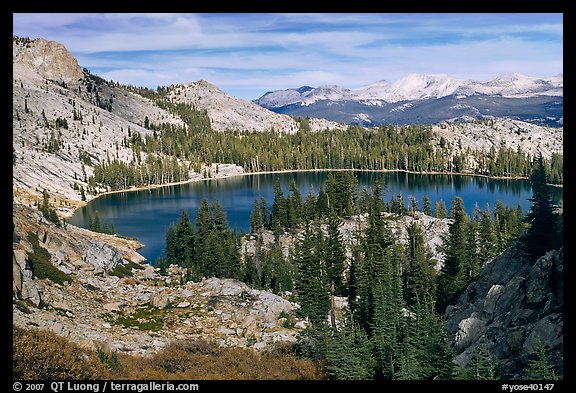
Above the lake, as the trail became more steep, gaining 2000 feet in the remaining 4 miles to the summit, nice views opened up over May Lake.
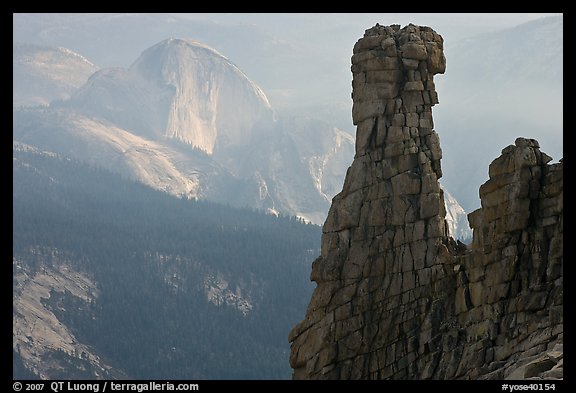
Further up the trail, looking South, Half-Dome was seen from an unusual angle. Unfortunately, although autumn atmosphere is normally very clear, the clouds that helped create great light in the Valley caused a lot of haze in that direction.
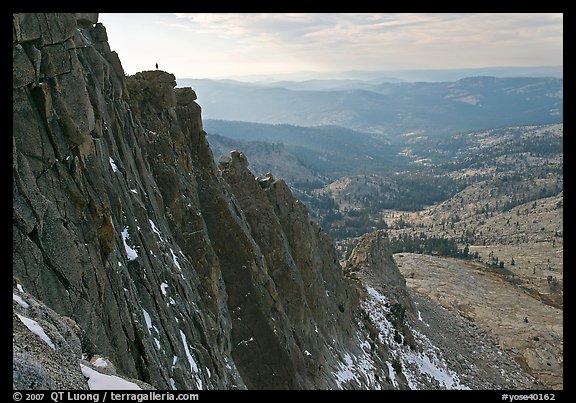
After scrambling on blocks past the end of the trail, we reached the summit. The view over sheer cliffs on the other side was vertiginous. I asked Tom to stand on the rim to give a sense of scale, as I photographed towards the hazy West.

Looking towards the East, I could recognize all the typical rock domes surrounding the Tuolumne Meadows area.

As sunset was getting closer, ridges in the East became more colored, however the foreground was in too deep of a shade on the North Side for a wide-angle view.
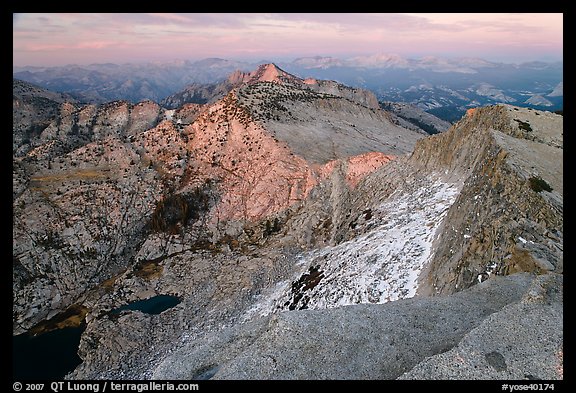
As is often the case, the light softened at twilight. After a last exposure, we hastily climbed down the summit blocks, which would be tricky to navigate by dark.
More images of May Lake and Mount Hoffman
Part 5 of 6: 1 | 2 | 3 | 4 | 5 | 6
Check out my book: Spectacular Yosemite
The production is not as impressive as the Helma calendars, but it is still a nice 11×14 size and they are actually more practical as there is space for notes. Unlike the previous years, I will not be offering them for direct sale (takes too much time to fulfill orders), but if interested you could purchase them directly from their store.
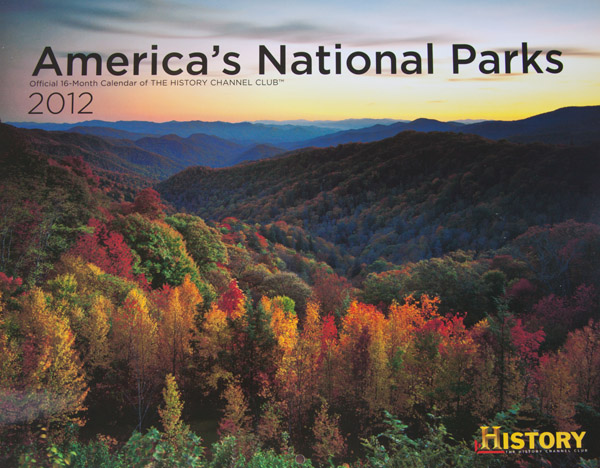
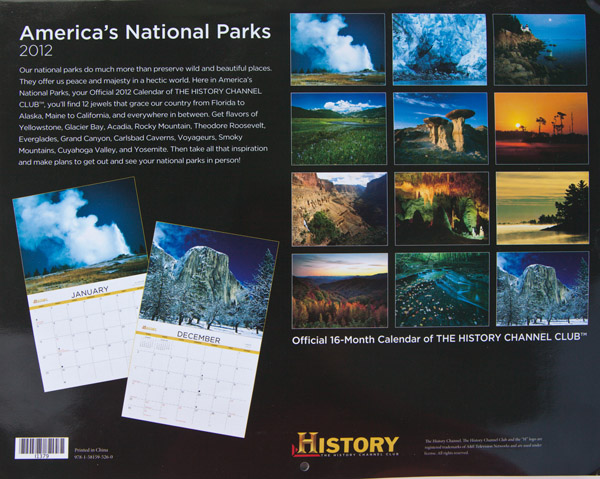
One month ago, I returned to the National Heritage Museum in Lexington for a second artist lecture. I’d like to thank the almost 200 attendees who came although the weather outside was great this day. The event was initially going to coincide with the closing of “Treasured Lands”. However the museum has decided to extend the exhibit a third time, until March 21, 2012.
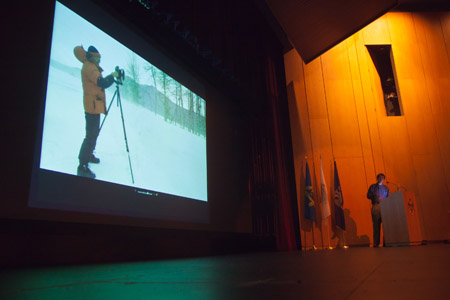
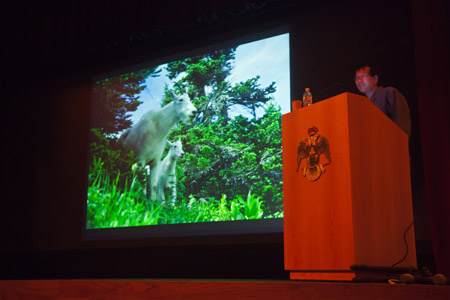

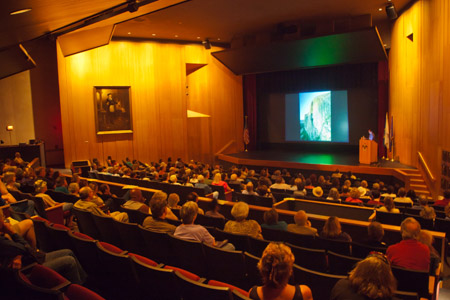
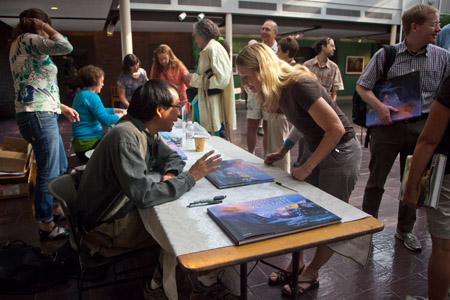
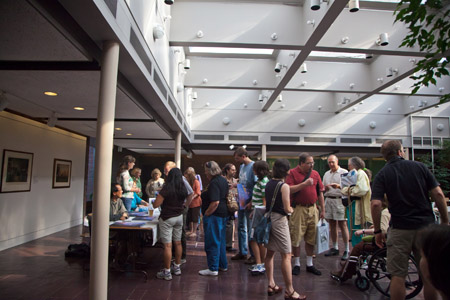
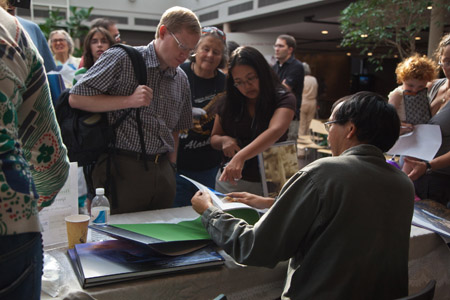
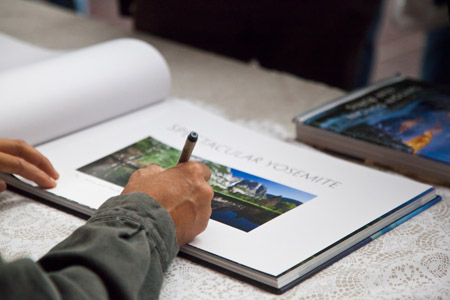
The evening of the day before the lecture, I was still photographing past sunset time on the top of the South Bubble in Acadia National Park (I’ll share a few new images from that trip in a subsequent post), more than five hours away.
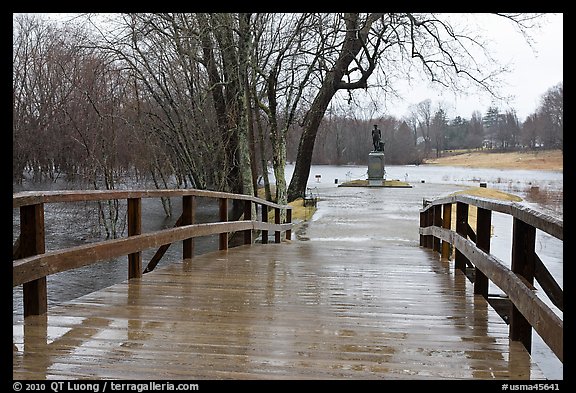
When the book signing session was over (only 1 copy remaining out of 40 books) I went back to Minute Man National Historical Park, where I had photographed a year and half ago during a rainstorm with such high winds that my umbrella was blown away when I held it under my arm to try to take a picture.

This time, in the late summer afternoon, the area radiated pastoral peace. Lexington and Concord are relatively small towns, however they are home to sites of great historical and literary significance to America. The rural stretch between the two towns was the site of some of the fiercest fighting on the day that started the events of the American Revolution.
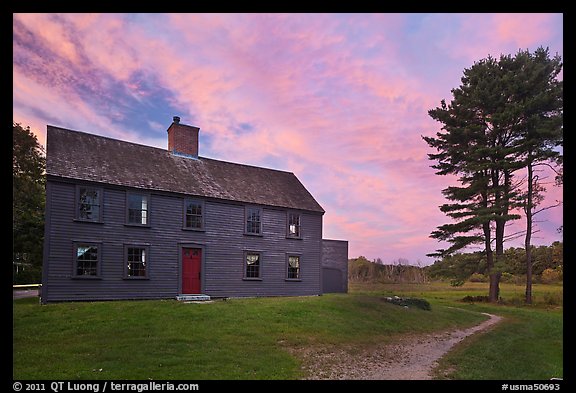
I hiked parts of the Battle Road trail, and just as I reached its end a Merriam’s corner, the sunset illuminated a beautiful sky.
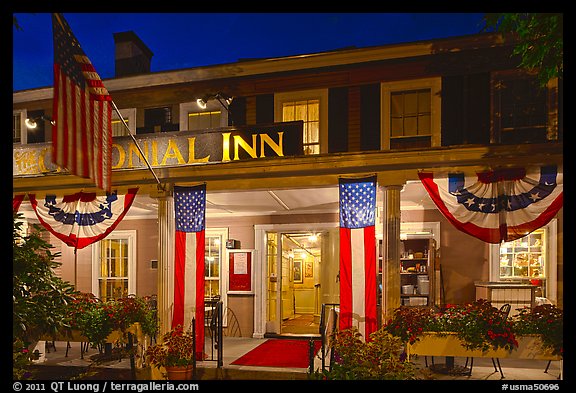
After dark, I headed to Concord for a bit of night photography. It was late when I began looking for dinner. As the 18th century Colonial Inn looked a bit too fancy for my taste, I tried instead to find a table in the main street cafe, from which appealing tunes where emerging.
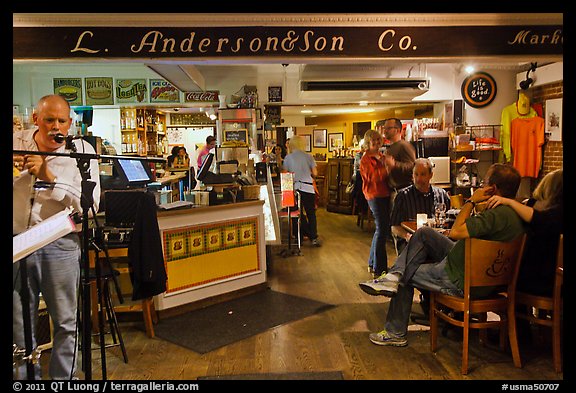
The waiter couldn’t find a table for me, and suggested I return 15 minutes later, which I did to no avail. Jack, with whom we had chatted about photography on the sidewalk, offered me a spot on the table he was sharing with his wife. When they left the cafe, he surprised me by telling me that dinner was on them. This was the second straight year that hospitality was extended to me by New Englanders who were total strangers. Last year, when I visited Isle au Haut, upon learning that I was a photographer while talking on the mail boat, a man gave a ride to his cabin, where he treated me to drinks and snacks before offering me a stay there.
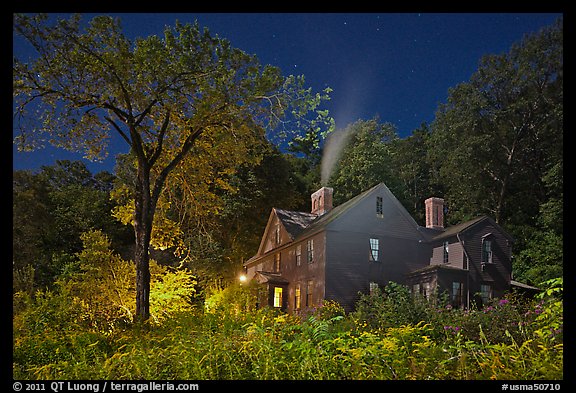
Feeling in good spirits, instead of looking for a hotel, I resumed photography in spite of the late hour. I had found the light at Louisa May Alcott’s house not to convey the feelings evoked by her books during the day, but at night, with the aid of a flashlight, it was just perfect.
Last December, I visited Phu Quoc Island for a few days. Located in the Gulf of Thailand, south of the mainland Vietnam, the island is the largest in Vietnam, measuring 31 mi (50 km) long and 16 mi (25 km) wide. It is famous through Vietnam for its fishing industry, and in particular fish sauce, however the increasing attraction nowadays resides in its long beaches, many of them remain free of any development, except for a few fishermen’s huts.
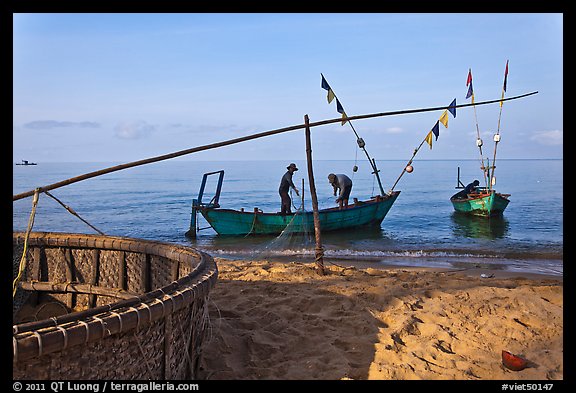
The flight from Ho Chi Minh city took only about one hour ($100 one-way), landing very close to the center of the main town, Duong Dong. In order to get around the island autonomously, I rented a motorcycle. While I would never dare to drive in the positively crazy traffic of Ho Chi Minh city, Phu Quoc Island appeared relaxed, as one would expect from a remote tropical island. As I hadn’t ridden a motorcycle in more than a decade (previous time was also in Vietnam !), the first moments after taking delivery of the bike were difficult, but afterwards I had no trouble.
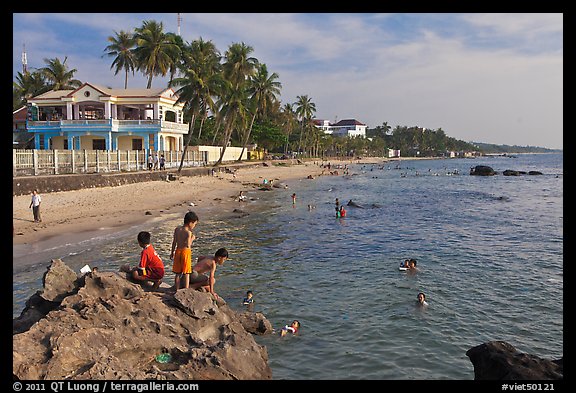
Then I decided to try and visit one of the famed fish sauce factories. I noticed that the most direct route from my hotel involved crossing a rudimentary mobile bridge, then the public market. The bridge was quite crowed, but by taking it slowly I was able to manage.
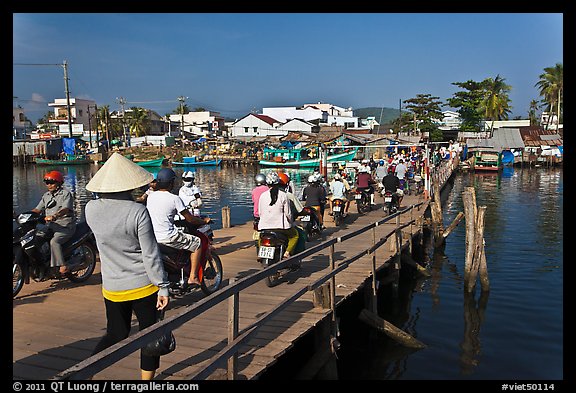
What I was not able to manage, though, was to ride through the public market, which turned out to be packed shoulder-to-shoulder. I got down the bike and tried to push it through, but with the crowds (and the weight of the bike), this too, proved problematic. By now, trying to turn the bike around to get to a less crowded spot, I was feeling seriously stressed. Just as I parked the bike near the market entrance, I was told this wasn’t a suitable spot. I looked frantically into my pants multiple pockets for the bike’s key. Left front pocket, right front pocket, back left pocket, back right pocket: nowhere to be found. What to do ?
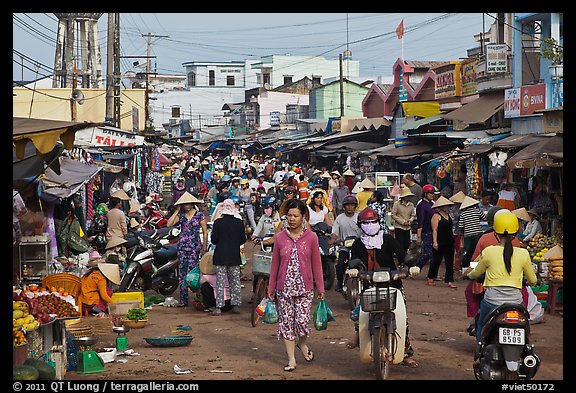
A motobike driver, who had been observing this clumsy, foreign-looking fellow, told me to go and see the locksmith, whose shop was just across the corner. The man informed me that he could make a new key on the spot, but that this would be expensive, as this is a difficult job. How much ? About US $4. I told him to proceed, quite skeptical that he would be able to cut such a complicated key without having the original to copy. He used just two tools, a metal wire, and a hand file. I was about to get a good lesson in Vietnamese ingenuity. I watched him with increasing fascination as he worked quickly and surely, first with the wire to probe the key contacts, then after making a sufficient number of notches on the key template, just with the key itself and the file. It took less than a quarter of an hour to recreate a fully functioning key, no less intricate than my own car’s key.

Interested in traveling to Vietnam ? Check the Vietnam photo tour that I will be co-leading in Fall 2012. Note that Phu Quoc Island is not included in that itinerary. As nice as it is to visit, I did not find enough interesting sights there. Our itinerary is designed to let you discover some of the most remarkable scenes in Vietnam within a relatively short time.
Kings Canyon National park was conceived by as a “wilderness park”, mostly free from development. There are only two sections accessible by car within the park, one around Grant Grove, the other in Cedar Grove. Both those sections are small: many visitors do not notice that shortly after Grant Grove, they exit the park, entering lands now protected as Giant Sequoia National Monument. Although I have often seen this view labeled as “Kings Canyon National Park, no lands belonging to the park proper can even be seen from this picture of the narrowest section of Kings Canyon, as the park is re-entered only in Cedar Grove.

In the past, I had explored at some length the most spectacular alpine sections of the park (such as Dusy Basin near the Sierra Crest, but visited Cedar Grove only for a day. This spring, with the publication of my Yosemite Book completed, I decided to spend only one week-end in Yosemite, saving more time for a return to Cedar Grove: could that glacial valley surrounded by tall cliffs, be another Yosemite Valley that I had overlooked ?
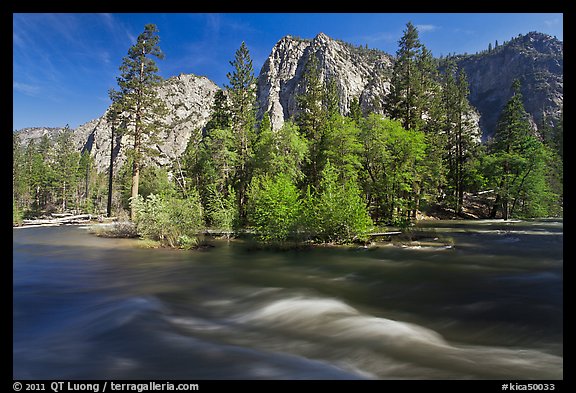
If that was the case, I was not the only one. Although I visited at the beginning of June, the Cedar Grove valley was remarkably quiet, nothing like the busy Yosemite Valley. The parking lots at the trailheads were never more than half-full. Even without a reservation, I had plenty of campsites to choose from. There was no need to stand elbow-to-elbow with other photographers, in fact nobody else was even standing near me when I took the images in this posting.
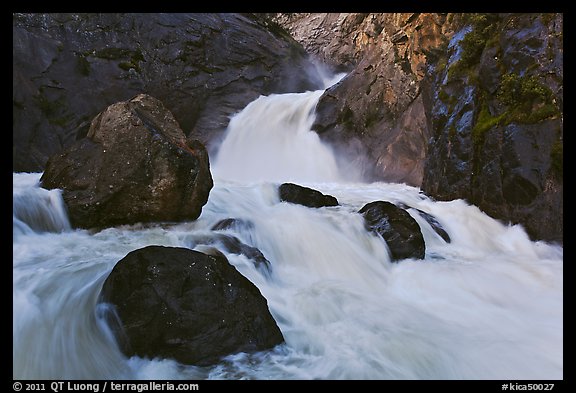
I realized that Cedar Grove lacked many features of Yosemite Valley, besides the crowds. The surrounding cliffs are not as monolithic, and there are no high waterfalls. The tallest one is Roaring River Falls, which looks more like a series of cascades. The short trail to this waterfall is the most popular in the park, together with Zumwalt Meadows, but besides, there are not many developed trails in Cedar Grove, and no great viewpoints from the valley rim (let alone easily accessible viewpoints such as Glacier Point). Even the meadows are smaller, making it difficult to get clear views of the entire valley. I found such views only at Zumwalt Meadows and on an un-named meadow close to Knapps Cabin.
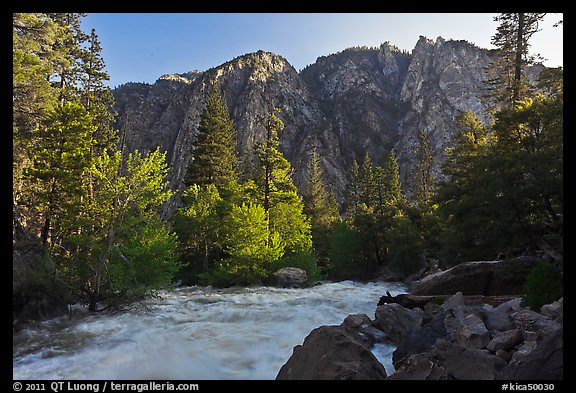
Although no long hiking was required, almost all the views required some exploring, instead of pulling out at a designated overlook, as is sometimes the case for Yosemite. I liked the fact that in Cedar Grove, although the place is easily accessible, I was able to work from a “blank slate” and actually had to find my own views, instead of being influenced by a vast repertoire of existing images, which are difficult to escape in Yosemite for someone who has any interest in the rich history of photography there. I created my own list of photo spots.
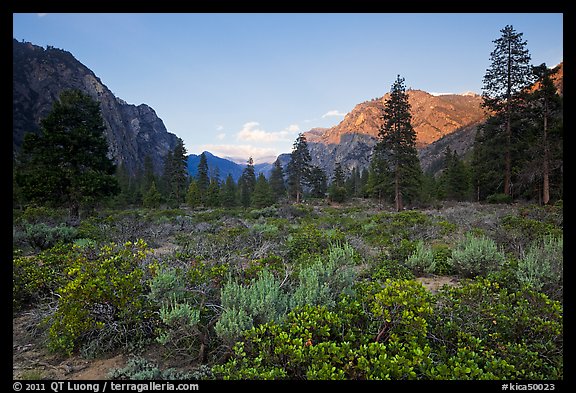
For a photographer looking to escape the beaten path, while photographing some beautiful Sierra scenery of cliffs, forests, meadows, and water, I’d recommend a visit to Cedar Grove.

Besides boat and helicopter, the only way to see the Na Pali Coast is to hike.

The Kalalau trail crosses some of the most lush and exotic terrain in the US.
 The Kalalau trail overlooks the Ocean all along the way. Many views are a glance through vegetation.
The Kalalau trail overlooks the Ocean all along the way. Many views are a glance through vegetation.
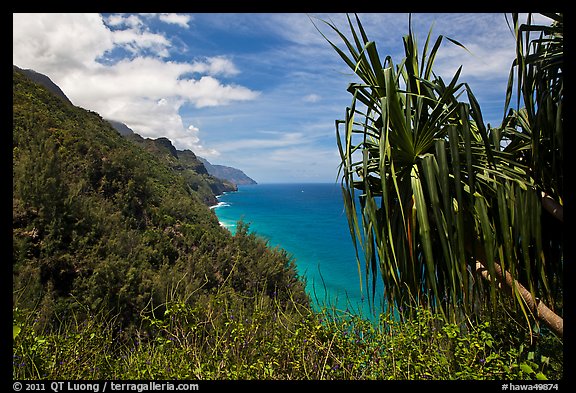
There are also a few open views, such as this one, only about 1/2 mile from the trailhead.
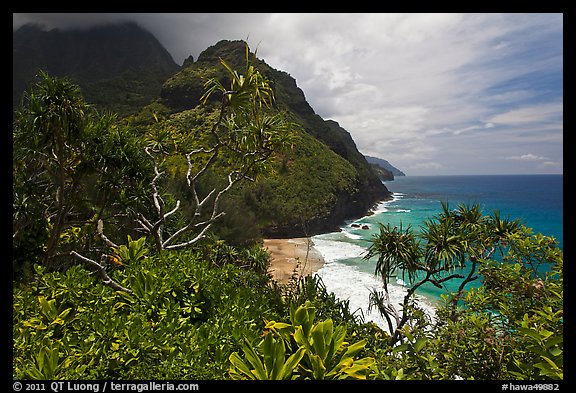
The Kalalau trail is 11 mile, but as a day hike with kids (5.5 and 7) our objective last May was just the first beach along the trail, the Hanakapiai Beach, 2 miles from the trail head. Yet, we found we got a good flavor of the trail’s beauty.
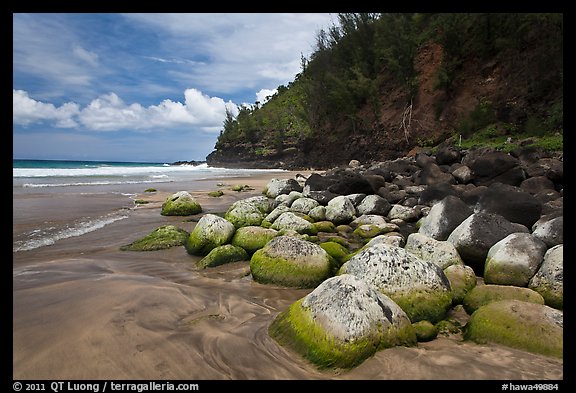
After hanging out at the beach, it was difficult to get the kids going back, hiking up in warm weather. Fortunately the next hike, that we did on a subsequent day, starting at a higher elevation, was cooler.

On the opposite end of the Na Pali Coast, the Pihea trail let you see the famous fluted cliffs (Pali in Hawaiian) from above.

Less than a mile from the trailhead, you are treated to a spectacular view of the Kalalau Valley, which is the terminus of the Kalalau trail.
In the summer of 1993, after moving to the San Francisco Bay area, inspired by the rich local tradition of US Western landscape photography, I began to use the large format camera. The more contemplative approach that this exacting type of photography promotes, and the extremely detailed prints it produces are perfect for making the viewer feel immersed in the land. I had found the perfect tool to share the sense of wonder and passion inspired by the US National Parks. Each image in the “Treasured Lands” exhibit was photographed using the same large format camera.
You need to operate such an instrument in a more deliberate way than a small format camera. Just to be able to see the composition, you need to put the camera on a sturdy tripod and slip under the a dark cloth – because the viewing glass is so dim. As everything is manual, not only focus and exposure, but also film transport, there are countless ways to ruin an image. The cost of each exposure adds to the time commitment it requires, favoring more conscious decision making. You need to make choices before shooting, rather than doing so after the shoot.
The primary reason for putting up with such a demanding camera – so heavy to carry in the wilderness – is the amount of detail recorded, thanks to the sheer dimensions of the sheet of 5×7 transparency film, whose surface area is about 25 times that of a 35mm (“full”) frame. Moreover, besides the focussing knobs, there are six other mechanical controls that affect perspective and sharpness distribution. For instance, by tilting the lens with respect to the film plane, I can get in perfect focus two objects that are at a different distance from the camera, rendering deep space in a uniformly clear way.
When I photograph a wide-angle scene, with an angle of view equivalent to that of a 24mm lens on 35mm camera, I am using a lens of 110mm focal length on my large format camera. A tree in the distant background is rendered as clearly as if I had focussed on it with a telephoto, and framed it tight. I do not need to direct the viewer’s attention to it, but they can discover that tree when they explore the image for themselves.
This descriptive power let me produce images that are complex, taking the whole scene in without a singular point of focus, because they have so much detail that the viewers could take time and read them, look at all the features, and discover highlights and inter-relationships for themselves.
In that sense, those photographs give a sense of place and time by letting the viewers see through the images as much as I saw myself. They allow them to stand before the landscape in a state of heightened awareness similar to mine. Although they would observe these natural wonders through my own celebratory perspective, they would realize that there is nothing they could not experience for themselves. Hopefully, this would help them recognize that those unique areas are truly treasures to be preserved and protected for future generations.
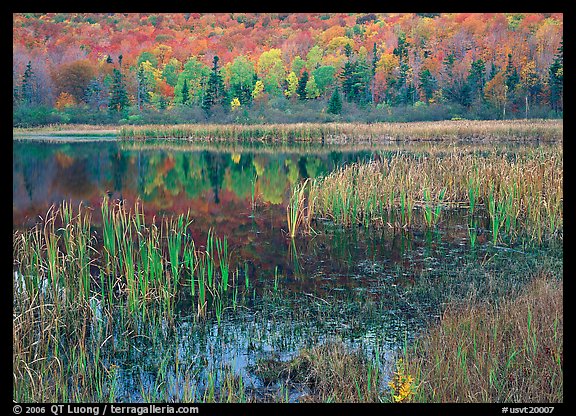
During my week on Kauai Island, since this was a family vacation, I often found myself on the beach at mid-day, close to Kilauea, since we were staying nearby. The second image is the site of Patrick Smith acclaimed Maestrom series. In those images, huge waves wash over the lava bench and drain back into the blowhole, but when I was there, the bench was never even close to getting wet. On those occasions, while the kids were playing around, I tried to put my theory to test, by (quickly) making long exposure images with a 10-fstop filter.
Do you think those mid-day seascapes work ?
